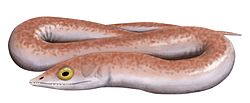| Osteolepiformes Temporal range: Middle Devonian to Late Carboniferous | |
|---|---|
 | |
| Osteolepis | |
| Scientific classification | |
| Kingdom: | Animalia |
| Phylum: | Chordata |
| Clade: | Rhipidistia |
| Clade: | Tetrapodomorpha |
| Class: | † Osteolepidida |
| Order: | † Osteolepiformes Berg, 1937 |
| Groups included | |
See text | |
| Cladistically included but traditionally excluded taxa | |
Osteolepiformes, also known as Osteolepidida, is a group of prehistoric lobe-finned fishes which first appeared during the Devonian period. The order contains the families Canowindridae, Megalichthyidae, Osteolepididae and Tristichopteridae, in addition to several monotypic families. The order is generally considered to be paraphyletic because the characters that define it are mainly attributes of stem tetrapodomorphs. [1]
The following taxonomy is based on Borgen & Nakrem, 2016: [2]
- Order †Osteolepiformes
- Suborder † Osteolepidoidei
- Family † Osteolepididae
- Family † Thursiidae
- Family † Megalichthyidae
- Suborder † Cyclolepidoidei
- Superfamily † Eopodoidea
- Family † Chrysolepididae
- Family † Gyroptychiidae
- Family Panderichthyidae (incl. Elpistostegalia)
- Family † Tristichopteridae
- Superfamily † Parapodoidea
- Family † Canowindridae
- Family † Medoevididae
- Superfamily † Rhizodontoidea
- Superfamily † Eopodoidea
- Suborder † Osteolepidoidei
Below is a cladogram showing the paraphyly of Osteolepiformes compiled and modified from Ahlberg and Johanson (1998). [1] See also Swartz (2012). [3] Osteolepiformes is marked by the green bracket.
Osteolepiformes |





